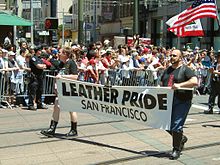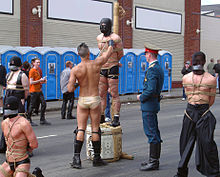Leather scene

The leather scene is the subculture of homosexuals who practice BDSM and regard leather as the fetishistic unifying element of their groups.
history
After the Second World War, the American motorcyclist subculture developed into the male homosexual leather scene, to which large parts of today's BDSM ideas can be traced.
Development in the USA

In his 1972 published book Leatherman's Handbook , Larry Townsend summarized these ideas, which would later be referred to as the " Old Guard " leather movement. The code of conduct described in this work was based on strict formal requirements and fixed roles in relation to the behavior of those involved ( e.g. no switching ) and had little relation to lesbians and heterosexuals.
The so-called New Guard leather movement emerged in the 1990s as a reaction to the restrictions underlying the Old Guard leather movement. This new orientation welcomed the switching and began on the one hand to integrate intellectual aspects into their game and on the other hand increasingly to give up the strict perception of roles and rejection of heterosexuals and women in this context.
In the summer of 1979, Samois was the first feminist lesbian group to emerge, which in the 1980s was politically committed to the rights of lesbian sadomasochists . Her title Coming to Power , published in 1981, also led to an increased acceptance and understanding of the subject of BDSM in the lesbian community. Against the resistance of the organizers, the group took part in the Gay Freedom Day Parade together with the BDSM group Janus , and for the first time wore t-shirts with the words " The Leather Menace " on them. This is considered the first open appearance of a sadomasochistic lesbian group at a public event. The open participation of the group at this event made clear for the first time differences to a subset of non-adomasochist lesbians who see BDSM as the basis of misogyny and violent pornography.

As a result, there was massive censorship in the lesbian subculture. The resulting ideological conflict lasted for decades and laid the basis for a dispute that continues to this day, known in the Anglo-Saxon world as the Feminist Sex Wars . This resulted in sometimes extremely aggressive clashes with various feminist organizations such as Women Against Violence in Pornography and Media (WAVPM) and Women Against Pornography . Prominent representatives of the resulting theoretical discussion are z. B. Patrick Califia and Gayle Rubin and on one side and Andrea Dworkin and Catharine MacKinnon on the other. The work of the advocates led to the development of sex-positive feminism . The discourse on the legitimacy of female sadomasochism continues to this day. In the German-speaking area, the discussion about the PorNO campaign took up the most important arguments and demands of the anti-pornographic side, but a comparably intense discussion among feminists was largely absent, as the theses of the debate were mostly only transferred in the critical partial aspects.
Development in Germany
After the amendment to Paragraph 175 , the “leather guys ” belonged to the most conspicuous representatives of homosexuals in West Germany in the 1970s, alongside the so-called “ queens ” .
Originally, the leather men identified with the rockers , those in public as particularly masculine and active, but also as aggressive motorcycle riders and men dressed in leather.
There were few commercially operated meeting places for leather men in the 1970s. In order to be able to live out the common interest in the leather fetish, associations, also known as leather clubs, were founded. Since registering a homosexual club was problematic at the time, many clubs were founded under the guise of a motorsport club. For this reason, many leather clubs in Europe still have the "MSC" in their club name.
At the beginning of the 1970s, the first "leather bars" opened in the USA and Europe, and only people with leather clothing could enter. At this time so-called motorcycle meetings arose . The booklet Der Stiefel was published in Hamburg, informing interested leather fans about topics and dates of interest to them.
In 1974 the ECMC , the European Confederation of Motorcycle Clubs , an association of leather clubs from various European countries , was founded in London . In 2005 about 5000 members from 44 leather clubs across Europe were organized in the ECMC.
In October 1974 a leather club was founded in Berlin, the Motorsport Club Berlin (MSC) , which was entered in the Berlin register of associations in 1978 and was henceforth called Motorsport und Contacte Berlin eV .
In 1979 the German umbrella organization, the SKVdC , the permanent conference of representatives of German-speaking clubs, was founded . With AIDS , which appeared in the first half of the 1980s, the work of the SKVdC expanded to include the tasks of AIDS prevention. Working groups were set up that meet several times a year with representatives from the German AIDS Association . In 2000 the SKVdC changed its name to LFC - Leather and Fetish Community . This name change resulted from a new role for fetish-oriented homosexual interest groups. In 2006, 13 leather and fetish clubs from Germany, Switzerland and Austria were organized in the LFC.
Due to the increasing emergence of commercial fetish bars and new communication options via the Internet (e.g. the chat platform GayRomeo ), the importance of leather clubs as meeting places for leather men dwindled. In addition to leather, other materials increasingly appeared in the fetish scene, especially rubber, skingear, sportswear and uniform. The leather clubs today see themselves mainly as fetish clubs. In public they are mostly noticed today through large fetish and motorcycle meetings. A few leather clubs operate their own club premises.
The members of leather clubs or leather gays themselves are sometimes referred to in the scene as leather sisters . Depending on the context, this designation is either pejorative or indicates belonging.
Development in Great Britain
In the 1990s, the Spanner Case convicted members of the leather scene in the UK for engaging in consensual sadomasochistic practices. The proceedings resulted in a landmark judgment by the European Court of Human Rights . Two of those arrested committed suicide and several lost their jobs. In eight cases, prison terms of up to four and a half years were pronounced.
Events
Folsom Street Fair
The Folsom Street Fair is an open-air event, held annually on the last Sunday in September, the Leather Pride Week in San Francisco , California decides. The major event has been held since 1984 and is the world's largest festival for the leather scene. It is the third largest public event in California and the largest exhibition for BDSM equipment and culture worldwide.
In Berlin , an association from the local leather scene in the Schöneberg district has been holding a corresponding event every September under the name Folsom Europe since 2004 .
International Mr. Leather
The election for the International Mr. Leather has been held annually in Chicago since 1979 . Over 50 candidates from Europe, the United States, Australia and Canada attend the event each year.
Museums
The Leather Archives and Museum (LA&M) is an establishment of the international leather scene and part of the BDSM and fetish subculture, headquartered in Chicago . The facility has one of the largest archives as well as one of the largest museums on the subject worldwide and is internationally unique in its conception.
media
- In the early 1980s, William Friedkin released his controversial film Cruising with Al Pacino , which shows scenes from the gay subculture.
See also
Individual evidence and further information
- ↑ See the detailed description by Robert Bienvenu: The Development of Sadomasochism as a Cultural Style in the Twentieth-Century United States. 2003, online as PDF under Sadomasochism as a Cultural Style
- ↑ cf. Anne-Marie Cusac: Profile of a sex radical - lesbian, sadomasochist author Pat Califia , The Progressive, October 1996, online at: Profile of a sex radical ( Memento from July 8, 2012 in the web archive archive.today )
literature
- Allan Bérubé : Coming Out Under Fire: The History of Gay Men and Women in World War Two. Free Press, 2000, ISBN 0-7432-1071-9 .
- David Carter , Stonewall: The Riots That Sparked the Gay Revolution. St. Martin's Griffin, 2005, ISBN 0-312-34269-1 .
- Martin Bauml Duberman : Stonewall. Plume, 1994, ISBN 0-452-27206-8 .
- Elizabeth Kennedy , Madeline Davis : Boots of Leather, Slippers of Gold: The History of a Lesbian Community. Penguin, 1993, ISBN 0-14-023550-7 .
- Samois : Coming to Power. Writings and Graphics on Lesbian S / M. 3. Edition. Alyson Publications , Boston 1987, ISBN 0-932870-28-7 .
- Pat Califia : A Personal View of the History of the Lesbian S / M Community and Movement in San Francisco. In: Coming to Power: Writings and Graphics on Lesbian S / M.
- Pat Califia (Ed.), Robin Sweeney (Ed.): The Second Coming: A Leatherdyke Reader. Alyson Pubns, 1996, ISBN 1-55583-281-4 .
- Larry Townsend : The Leatherman's Handbook: Silver Jubilee Edition. 6th revised edition (paperback). L. T. Publications, 2000, ISBN 1-881684-19-9 .
- Gayle Rubin : The Valley of the Kings: Leathermen in San Francisco, 1960–1990. 1994, Dissertation Abstracts International, 56 (01A), 0249. (UMI No. 9513472).
- David Stein : S / M's Copernican Revolution: From a Closed World to the Infinite Universe and Safe Sane Consensual: The Evolution of a Shibboleth. Under s / m-leather history .
- Robert Bienvenu : The Development of Sadomasochism as a Cultural Style in the Twentieth-Century United States. Dissertation, Indiana University 1998, 2003, online PDF under Sadomasochism as a Cultural Style.
